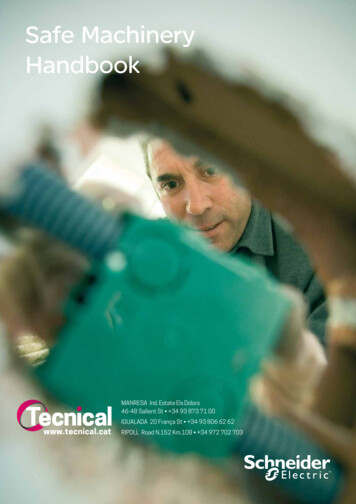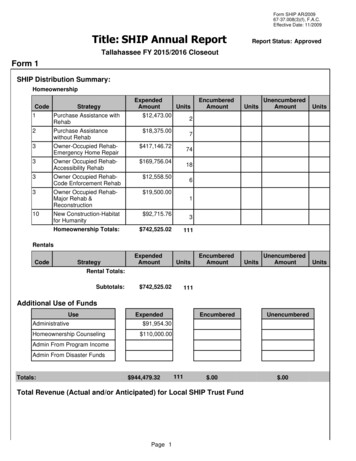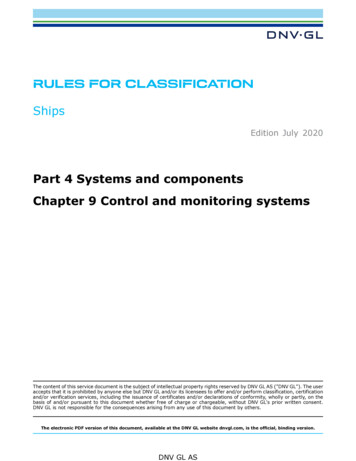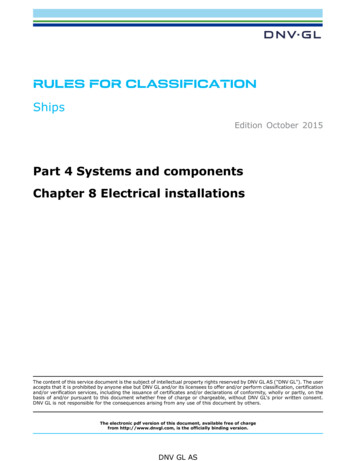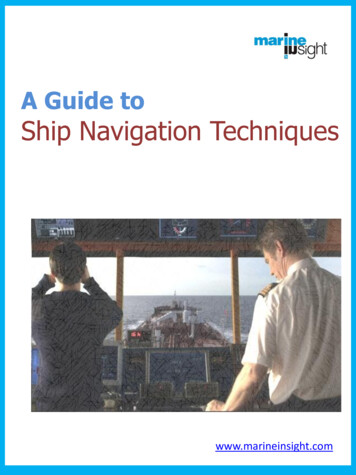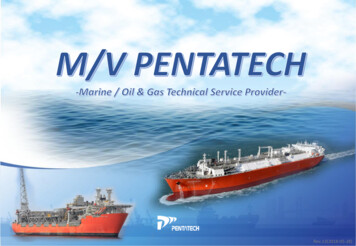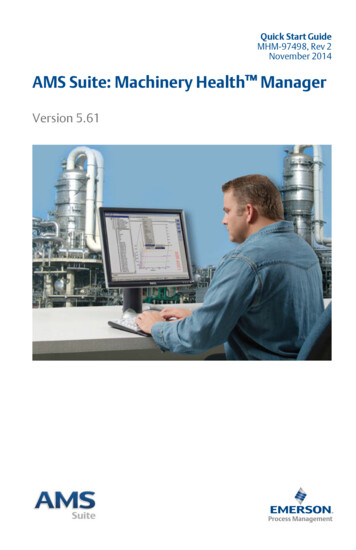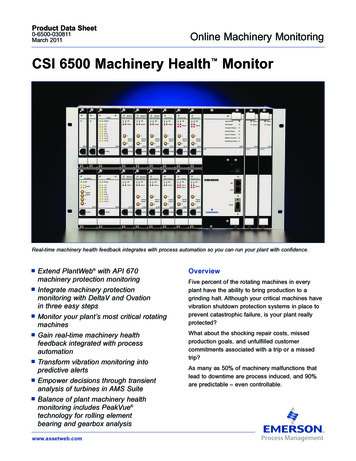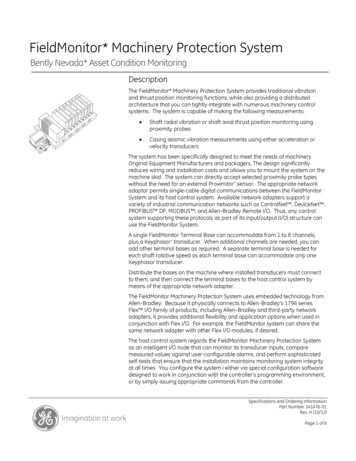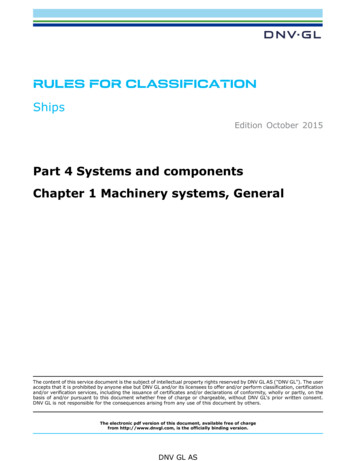
Transcription
RULES FOR CLASSIFICATIONShipsEdition October 2015Part 4 Systems and componentsChapter 1 Machinery systems, GeneralThe content of this service document is the subject of intellectual property rights reserved by DNV GL AS ("DNV GL"). The useraccepts that it is prohibited by anyone else but DNV GL and/or its licensees to offer and/or perform classification, certificationand/or verification services, including the issuance of certificates and/or declarations of conformity, wholly or partly, on thebasis of and/or pursuant to this document whether free of charge or chargeable, without DNV GL's prior written consent.DNV GL is not responsible for the consequences arising from any use of this document by others.The electronic pdf version of this document, available free of chargefrom http://www.dnvgl.com, is the officially binding version.DNV GL AS
FOREWORDDNV GL rules for classification contain procedural and technical requirements related to obtainingand retaining a class certificate. The rules represent all requirements adopted by the Society asbasis for classification. DNV GL AS October 2015Any comments may be sent by e-mail to rules@dnvgl.comIf any person suffers loss or damage which is proved to have been caused by any negligent act or omission of DNV GL, then DNV GL shallpay compensation to such person for his proved direct loss or damage. However, the compensation shall not exceed an amount equal to tentimes the fee charged for the service in question, provided that the maximum compensation shall never exceed USD 2 million.In this provision "DNV GL" shall mean DNV GL AS, its direct and indirect owners as well as all its affiliates, subsidiaries, directors, officers,employees, agents and any other acting on behalf of DNV GL.
Part 4 Chapter 1 Changes - currentCHANGES – CURRENTThis is a new document.The rules enter into force 1 January 2016.Rules for classification: Ships — DNVGL-RU-SHIP-Pt4Ch1. Edition October 2015Machinery systems, generalDNV GL ASPage 3
Changes – current. 3Section 1 General Requirements. 61 Classification.61.1 Application. 62 Definitions. 73 Documentation requirements for builder. 93.1 Documentation requirements. 94 Certification and documentation requirements for Manufacturers.94.1 Certification requirements. 94.2 Documentation requirements. 95 Tests. 105.1 Testing of machinery systems and components. 10Section 2 Materials. 111 General. 111.1 Machinery parts. 111.2 Use of asbestos. 11Section 3 Design Principles. 121 Arrangement. 121.1 General. 121.2 Prevention of inadvertent operations.121.3 Communication and engineers’ alarm.131.4 Fire protection. 131.5 Requirements dependent upon damage stability calculations. 141.6 Potentially hazardous, non-essential installations. 142 Construction and Function. 152.1 General. 152.2 Environmental conditions.152.3 Functional capability and redundancy. 162.4 Failure effects. 182.5 Component design.183 Reliability and Availability. 193.1 Application.193.2 Reliability and availability analysis. 19Rules for classification: Ships — DNVGL-RU-SHIP-Pt4Ch1. Edition October 2015Machinery systems, generalDNV GL ASPage 4Part 4 Chapter 1 ContentsCONTENTS
4.1 General. 20Section 4 Control of Machinery. 211 Control and Monitoring. 211.1 General. 211.2 Remote control of machinery. 211.3 Bridge control of machinery.221.4 Bridge control of propulsion machinery. 221.5 Supervision from a control room. 231.6 Operation with periodically unattended machinery spaces. 23Section 5 Spare Parts.251 General. 251.1 Machinery installations. 251.2 Tables of recommended spare parts.25Rules for classification: Ships — DNVGL-RU-SHIP-Pt4Ch1. Edition October 2015Machinery systems, generalDNV GL ASPage 5Part 4 Chapter 1 Contents4 Personnel Protection. 20
1 Classification1.1 Application1.1.1 This chapter contains overall requirements common for machinery, systems and components. Detailedrequirements are given in the relevant rule chapters in Pt.4 - Systems and components .1.1.2 The rules in this chapter apply to machinery, systems and components for ships and barges for theassignment of main class.1.1.3 For novel design of a component, a system or the complete arrangement of a vessel, and where theexisting rules are not suitable for the purpose, the design can be accepted provided that the overall safetyand availability level is found to be equivalent or better than that of the rules. The Society withholds the rightto request documentation, tests and trials additional to those specified in the rules.For such designs an engineering analysis shall be prepared and submitted. The analysis shall as a minimuminclude the following elements:1)2)3)4)5)6)7)Thorough definition of the ship, ship systems and components subject to the analysis.Identification of requirements with which the ship or design will not comply.Identification of the possible hazards introduced by the design.Identification of failure modes, consequences of failures and system response (e.g. FMEA) and a testprogram to verify the conclusions.Determination of the required performance, safety and availability criteria addressed by correspondingrequirements applicable for traditional design.Design philosophy and detailed description of the novel design, including a list of the assumptions usedin the design and any proposed operational restrictions or conditions.Technical justification demonstrating that the alternative design and arrangements meet the requiredperformance criteria in accordance with the above.Guidance note:1)For new technology, Recommended Practice DNVGL-RP-A203 can be a suitable basis for such analyses.2)Refer also to Pt.1 Ch.1 Sec.1 regarding alternatives to detailed requirements in the 1.1.4 Compliance with the rules is required for installations and equipment necessary for performing themain functions given in Pt.1 Ch.1 Sec.1 [1.2].1.1.5 The rules give system requirements and prescribe minimum requirements for materials, design,manufacture, inspection and testing.1.1.6 For components to be installed onboard vessels with the class notation Naval, additional requirementsgiven in Pt.5 Ch.13 shall be fulfilled.Rules for classification: Ships — DNVGL-RU-SHIP-Pt4Ch1. Edition October 2015Machinery systems, generalDNV GL ASPage 6Part 4 Chapter 1 Section 1SECTION 1 GENERAL REQUIREMENTS
Table 1 DefinitionsTermDefinitionActive componentsActive components are components for mechanical transfer of energy, e.g.pumps, fans, electric motors, generators, combustion engines and turbines. Heatexchangers, boilers, transformers, switchgear or cables are not considered to beactive components.Availability is the ratio of actual service time to expected service time at sea.Availability may be calculated from the following formula:AvailabilityEngine room is the spaces containing propulsion machinery and machinery forgeneration of electrical power.Guidance note:Engine roomRooms within or adjacent to the engine room with visual contact with the machineryshould be considered to be part of the engine ailureFailure in the rule context is a sudden event or deterioration causing loss offunction.Independently drivenAn independently driven component is, when the function of the component and thepower supply of the component is independent of the main engine.Load reductionLoad reduction, implies that a unit is brought to a safe state under the prevailingconditions, but the reduction shall be limited to a degree where the function the unitserves is not lost, only degraded.“Machinery spaces”“Machinery spaces are all machinery spaces of category A and all other spacescontaining propulsion machinery, boilers, oil fuel units, steam and internalcombustion engines, generators and major electrical machinery, oil filling stations,refrigerating, stabilizing, ventilation and air conditioning machinery, and similarspaces, and trunks to such spaces.”(SOLAS Ch. II-1/3.16)“Machinery spaces of category A are those spaces and trunks to such spaces whichcontain:“Machinery spaces of category A”1)internal combustion machinery used for main propulsion; or2)internal combustion machinery used for purposes other than main propulsionwhere such machinery has in the aggregate a total power output of not lessthan 375 kW; or3)any oil-fired boiler or oil fuel unit.”(SOLAS Ch. II-1/3.17)Mean time to failure (MTTF)Mean time to failure (MTTF) is the mean value of service time until failure occurs.In the rule context, MTTF shall be considered to be equal to mean time betweenfailures (MTBF).Rules for classification: Ships — DNVGL-RU-SHIP-Pt4Ch1. Edition October 2015Machinery systems, generalDNV GL ASPage 7Part 4 Chapter 1 Section 12 Definitions
Mean time to repair (MTTR) is the mean value of time from occurrence of failure tore-establishment of lost function.Mutual independenceMutual independence between components means that the function of thecomponents and their power supply shall not dependent on some commoncomponent or system.Novel designNovel design is defined as technology or solutions for which the application ofprescriptive requirements in the rules of the Society is not suited.Piping shall be defined to include the following components:— pipes— flanges with gaskets and bolts and other pipe connectionsPiping— expansion elements— valves, including hydraulic and pneumatic actuators, and fittings— hangers and supports— flexible hoses— pump housings.Piping systemA piping system shall be defined to include piping, as well as components in directconnection to the piping such as pumps, heat exchangers, evaporators, independenttanks etc. with the exception of main components such as steam and gas turbines,diesel engines, reduction gears and boilers.For components that are subject to internal pressure and are not included in thepiping system, the design requirements in Ch.7 apply.RedundancyRedundancy is the ability to maintain or restore a function when one failure hasoccurred. Redundancy can be achieved for instance by installation of more than oneunit (component redundancy) or by having two or more separate systems capableof performing the same function (system redundancy).Redundancy types are defined by the time lag accepted upon restoring a lostfunction, due to failure in a component or system, designed with redundancy.Redundancy typesReliabilityRedundancy type0123not definedTime lag in re-establishment of functionNone (continuously available)Up to 30 sUp to 10 minutesUp to 3 hoursMore than 3 hoursReliability is the ability of a component or a system to perform its required functionwithout failure during a specified time interval.Repairable failure in the machinery is a failure which is possible to be repair onboard and for which the following conditions are fulfilled:Repairable failureShut down1)the machinery is arranged and designed to allow for repair work at sea2)spare parts or complete spare units necessary for permanent or provisionalrepairs are kept on board3)tools, instruction manuals and other necessary facilities to perform the repairwork are kept on board.Shut down, implies that a unit is brought to a safe state. The safe state may be stopof a unit or decelerate rotating machinery to idle.Rules for classification: Ships — DNVGL-RU-SHIP-Pt4Ch1. Edition October 2015Machinery systems, generalDNV GL ASPage 8Part 4 Chapter 1 Section 1Mean time to repair (MTTR)
3.1 Documentation requirements3.1.1 Documentation of machinery and systems shall be submitted to the extent specified in the followingchapters containing all the data necessary for approval. Where necessary, calculations and descriptions of theplant are to be submitted.3.1.2 The Builder shall submit the documentation required by Table 2.Table 2 Documentation requirements for the builderObjectDocumentation typeAdditional descriptionInfoPropulsion control andmonitoring systemsI020 - Control systemfunctional descriptionPre-warning and override facility for load reductionsand shut-downs.APAP For approval3.1.3 For general requirements to documentation, including definition of the Info codes, see Pt.1 Ch.3 Sec.2.3.1.4 For a full definition of the documentation types, see Pt.1 Ch.3 Sec.3.4 Certification and documentation requirements for Manufacturers4.1 Certification requirements4.1.1Machinery systems and components shall be certified according to the requirements in the relevant rulechapters for the systems and components. Additionally, products shall be certified as required by Table 3.Table 3 Certification requiredObjectCertificate typeIssued byPropulsion control andmonitoring systemsPCSocietyCertification standard*Additional description*Unless otherwise specified the certification standard is the Society's rules4.1.2 For general certification requirements, see Pt.1 Ch.3 Sec.44.1.3For a definition of the certification types, see Pt.1 Ch.3 Sec.5.4.2 Documentation requirements4.2.1For products required to be certified, the Manufacturer shall submit the documentation required by Table 4.Rules for classification: Ships — DNVGL-RU-SHIP-Pt4Ch1. Edition October 2015Machinery systems, generalDNV GL ASPage 9Part 4 Chapter 1 Section 13 Documentation requirements for builder
ObjectDocumentation typePropulsion control andmonitoring systemsI200 - Control andmonitoring systemdocumentationAdditional descriptionInfoAPAP For approval4.2.2For general requirements for documentation, including definition of the info codes, see Pt.1 Ch.3 Sec.2.4.2.3For a full definition of the documentation types, see Pt.1 Ch.3 Sec.3.5 Tests5.1 Testing of machinery systems and components5.1.1 Machinery and its component parts shall be subject to constructional and material tests, pressure andleakage tests, and trials.In the case of parts produced in series, other methods of testing can be agreed instead of the testsprescribed, provided that the former are recognized as equivalent by the Society.5.1.2 The Society reserves the right, where necessary, to increase the scope of the tests and also to testthose parts which are not expressly required to be tested according to the rules.5.1.3 After installation on board of the main and auxiliary machinery, the installation as well as theoperational functioning of the machinery, including the associated ancillary equipment, shall be verifiedaccording to rule requirements in the following chapters. Safety functions and safety equipment shall betested as far as practically feasible. Tests for safety equipment that has formerly been performed andwitnessed by the Society need not to be repeated.In addition, the entire machinery installation is to be tested during sea trials, as far as possible under theintended service conditions.The tests shall be carried out according to approved test programmes, see Pt.1 Ch.1 Sec.2 [1.6].Rules for classification: Ships — DNVGL-RU-SHIP-Pt4Ch1. Edition October 2015Machinery systems, generalDNV GL ASPage 10Part 4 Chapter 1 Section 1Table 4 Documentation requirements - products required to be certified
Part 4 Chapter 1 Section 2SECTION 2 MATERIALS1 General1.1 Machinery parts1.1.1 Requirements for documentation of quality and testing of materials intended for:——————propulsion and auxiliary machineryboilers and pressure vesselselectrical installationsinstrumentation and automationfire protection, detection and extinctionpiping systemsare given in the respective chapters of Pt.4.1.2 Use of asbestos1.2.1 The use of asbestos is prohibited (Ref. Pt.1 Ch.1 Sec.2 [1.2.4] and Pt.1 Ch.1 Sec.4 [1.2.3]).Rules for classification: Ships — DNVGL-RU-SHIP-Pt4Ch1. Edition October 2015Machinery systems, generalDNV GL ASPage 11
1 Arrangement1.1 General1.1.1 All machinery, systems and components that are to be operated or subject to inspection andmaintenance on board shall be designed and arranged for easy access.1.1.2 All components in a system shall be satisfactorily matched with regard to function, capacity andstrength. Relative motions between parts of the machinery shall be allowed for without inducing detrimentalstresses.1.1.3 All machinery shall be equipped with control and instrumentation considered necessary for safeoperation of the machinery.1.1.4 The following is applicable when local indication of pressure is required in the rules:— The scales of pressure gauges shall be dimensioned up to the specified test pressure. The maximumpermitted operating pressures shall be marked on the pressure gauges for boilers, pressure vessels and insystems protected by safety valves.— Pressure gauges shall be installed in such a way that they can be isolated.— Lines leading to pressure gauges shall be installed in such a way that the readings cannot be affected byliquid heads and hydraulic hammer.1.1.5 All spaces, from which machinery is operated and where flammable or toxic gases or vapours mayaccumulate, or where a low oxygen atmosphere may occur, shall be provided with adequate ventilation underall conditions.1.1.6 The capacity and arrangement of machinery spaces and emergency generator room ventilation shallcover demands for operating the machinery, boilers and emergency generator at full power in all weatherconditions.Ventilation inlets and outlets shall be located not less than 4.5 m above freeboard deck. Supply of air tothe engine room shall be ensured even in the event of failure of one ventilation fan. As an alternative tothe redundancy requirements in [2.3] alternative provision of air by adequate openings may be speciallyconsidered.The air inlets and air outlets on open deck shall be positioned such as to avoid the ingress of exhaust airthrough the inlet openings into machinery space (short circuiting of air).Guidance note:Necessary capacity of ventilation may be calculated according to ISO .1.7 If the pipe tunnels are entered via doors or hatches for operating (e.g. for normal operation of valvesor reading of measuring instruments) a mechanical ventilation shall be provided.If the pipe tunnels are entered from the engine room the engine room ventilation system may be accepted assufficient means of mechanical ventilation.1.2 Prevention of inadvertent operations1.2.1 The machinery shall be so arranged that inadvertent operation, caused by human error, cannot lead tothe reduced safety of the ship and personnel.Rules for classification: Ships — DNVGL-RU-SHIP-Pt4Ch1. Edition October 2015Machinery systems, generalDNV GL ASPage 12Part 4 Chapter 1 Section 3SECTION 3 DESIGN PRINCIPLES
1.2.3 Systems and tanks shall be so arranged that leakage or any operation of valves will not directly lead toincreased risk of damage to machinery, ship or personnel due to mixing of different fluids.1.2.4 Open or closed position of valves shall be easily visible.1.2.5 If a valve's function in the system is not evident, there shall be adequate information on a name plateattached to the valve.1.2.6 All connections to sea shall be marked:SEA DIRECT.1.3 Communication and engineers’ alarm1.3.1 At least two independent means shall be provided for communicating orders from the navigating bridgeto the position in the machinery space or in the control room from which the speed and direction of thrustof the propellers are normally controlled: one of these shall be an engine-room telegraph which providesvisual indication of the orders and responses both in the machinery spaces and on the navigating bridge.Appropriate means of communication shall be provided from the navigating bridge and the engine-room toany other position from which the speed or direction of thrust of the propellers may be controlled.(SOLAS Ch. II-1/37)1.3.2 An engineers' alarm capable of being operated from the engine control room or at the manoeuvringplatform, as appropriate, to alert personnel in the engineers' accommodation that assistance is needed in theengine room, shall be provided (see SOLAS Ch. II-1/38).1.4 Fire protection1.4.1 Where references have been given to SOLAS, this shall be taken as SOLAS 74 including amendmentscurrently in force.1.4.2 The arrangement of machinery spaces shall be so that safe storage and handling of flammable liquidsis ensured. Materials used as flooring, bulkhead lining, ceiling or deck in control rooms, machinery spaces orrooms with oil tanks shall be non-combustible.Guidance note:Reference is made to MSC.1/Circ.1321 – Guidelines for measures to prevent fires in engine rooms and cargo pump 1.4.3 Fuel oil, lubrication oil, hydraulic oil and thermal oil are in this context regarded as “Flammable liquids”.1.4.4 No tank containing flammable liquid shall be situated where spillage or leakage therefrom canconstitute a fire or explosion hazard, by coming into contact with heated surfaces (see SOLAS Ch.II-2/Reg.4.2.2.3.3).1.4.5 Flammable liquid lines shall not be located immediately above or near units of high temperature,including boilers, steam pipelines, exhaust manifolds, silencers or other equipment required to be insulatedby [1.4.7]. As far as practicable, flammable liquid lines shall be arranged far apart from hot surfaces,electrical installations or other sources of ignition and shall be screened or otherwise suitable protected toavoid liquid spray or liquid leakage onto the sources of ignition (see SOLAS Ch.II-2/Reg.4.2.2.5.3).Rules for classification: Ships — DNVGL-RU-SHIP-Pt4Ch1. Edition October 2015Machinery systems, generalDNV GL ASPage 13Part 4 Chapter 1 Section 31.2.2 The machinery and piping systems shall be arranged to prevent sea water, cargo or ballast fromreaching dry spaces of the ship or cargo (oils or chemicals) from being discharged overboard as aconsequence of inadvertent operations.
1.4.7 Surfaces with temperatures above 220 C which may be impinged as a result of a flammable oilsystem failure shall be properly insulated (see SOLAS Ch.II-2/Reg.4.2.2.6.1).1.4.8 Precautions shall be taken to prevent any flammable liquid that may escape under pressure from anypump, filter or heater from coming into contact with heated surfaces (see SOLAS Ch.II-2/Reg.4.2.2.6.2).1.4.9 The surface of insulation materials shall be impervious to oil or oil vapours (see SOLAS Ch.II-2/Reg.4.4.3).1.4.10 “The floor plating of normal passageways in machinery spaces of category A shall be made ofsteel” (SOLAS Ch.II-2/Reg.11.4.2).1.4.11 Hydraulic power units shall be provided with adequate shielding in order to avoid potential oilleakage, or spray coming into contact with any sources of ignition.1.4.12 When purifiers for heated fuel oil are not located in a separate room, consideration shall be given withregard to their location, ventilation conditions, containment of possible leakage and shielding from ignitionsources.3For machinery spaces of category A above 500 m , the purifiers shall be protected by a fixed local applicationfire-extinguishing system.Guidance note:Reference is made to SOLAS Ch.II-2/Reg.10.5.6 and IMO MSC/Circ.913 for requirements regarding the fixed local application fireextinguishing -1.5 Requirements dependent upon damage stability calculationsFor vessels where damage stability requirements apply, precautions shall be taken to preventintercommunication through damaged pipe lines between flooded and intact compartments.For this purpose, where any part of a pipe system is situated within the defined damaged area and thepipe line has an open end in a compartment assumed to be intact, an isolating valve situated outside thedamaged area operable from the freeboard deck or from another position, accessible when the ship is indamaged condition shall be fitted. For bilge lines the remotely operated stop valves may be substituted by anon-return valve.Guidance note:Requirements for damage stability may be found in inter alia SOLAS, the International Convention on Load Lines, MARPOL, IMO Gasand Chemical Codes and for the additional class notations SF and Well t-e---1.6 Potentially hazardous, non-essential installations1.6.1 Fixed refrigeration plants shall comply with the requirements in Ch.6 Sec.6.1.6.2 Ballast water treatment system installations shall comply with safety requirements in Pt.6 Ch.7 Sec.1.Rules for classification: Ships — DNVGL-RU-SHIP-Pt4Ch1. Edition October 2015Machinery systems, generalDNV GL ASPage 14Part 4 Chapter 1 Section 31.4.6 For detailed arrangement of tanks and piping conveying flammable liquids, see Ch.6.
2.1 General2.1.1 The machinery shall be so designed, installed and protected that risks of fire, explosions, accidentalpollution, leakage and accidents thereof will be acceptably low.2.1.2 Reliability and availability of the machinery shall be adapted according to considerations of theconsequences from machinery failures and disturbances.2.1.3 The design arrangement of machinery foundations, shaft connections, piping and ducting shalltake into account the effects of thermal expansion, vibration, misalignment and hull interaction to ensureoperation within safe limits.Bolts and nuts exposed to dynamic forces and vibrations shall be properly secured.2.2 Environmental conditions2.2.1 All machinery, components and systems covered by the rules shall be designed to operate under theenvironmental conditions given in Table 1 to Table 3 if not otherwise specified in the detailed requirements forthe machinery, component or system:Table 1 Water temperatureCoolantTemperature [ C]Seawater 321)Charge air coolant inlet to charge air cooler 321)1) The Society may approve other temperatures in the case of ships not intended for unrestricted service.Table 2 Air temperatureInstallations,Location,Temperature rangecomponentsarrangement[ C]In enclosed spaces0 to 45On machinery components, boilersMachinery and electrical installations2)In spaces, subject to higher or lowertemperaturesOn the open deck1)According to specificlocal conditions- 25 to 451)1) The Society may approve other temperatures in the case of ships not intended for unrestricted service.2) See Ch.9 Sec.5 for electronic appliances.Table 3 List, rolling, trim and pitchInstallations, components1)Angle of inclination (degrees)AthwartshipsRules for classification: Ships — DNVGL-RU-SHIP-Pt4Ch1. Edition October 2015Machinery systems, generalDNV GL AS2)Fore and aftPage 15Part 4 Chapter 1 Section 32 Construction and Function
Main and auxiliary machinery 15Safety equipment, e.g. emergency powerinstallations, emergency fire pumps andtheir devices, switch gear, electrical and3)electronic appliancesand remote controlsystems 22.54)DynamicStatic0 22.55)0 2
refrigerating, stabilizing, ventilation and air conditioning machinery, and similar spaces, and trunks to such spaces." (SOLAS Ch. II-1/3.16) "Machinery spaces of category A" "Machinery spaces of category A are those spaces and trunks to such spaces which contain: 1) internal combustion machinery used for main propulsion; or

